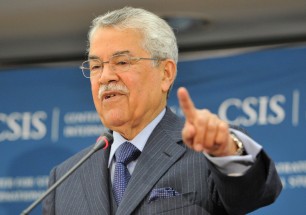
The Saudi oil minister’s visit to Venezuela this week is also a trip through time.
Flash back to December 1998 when Saudi Arabia looked to its fellow OPEC members for help lifting oil prices from about $10 a barrel.
Back then, the Saudis were defending their dominance in the global oil market from new suppliers in Latin America. Now the desert kingdom is cutting prices to the U.S. to contend with upstart shale producers. To win the showdown, the Saudis are trying to bring OPEC’s weaker members in line before the Nov. 27 meeting of the organization, said Seth Kleinman, head of European energy research at Citigroup Inc. in London.
Oil Prices
“Shale is in the Saudis’ sights,” Kleinman said by e-mail. “It’s going to be shale or it’s going to be OPEC.”
Ali Al-Naimi, Saudi Arabia’s oil minister, flew to Venezuela for a conference that starts this week, according to two people with direct knowledge of his plans who asked not to be identified because they’re not authorized to speak to the media. He’s due to attend a gas forum in Acapulco, Mexico, on Nov. 11 and 12.
The trip is reminiscent of the 1990s, when Saudi Arabia’s competition with Venezuela and Mexico for shipments to the U.S. Gulf Coast drove down prices, according to Mike Wittner, head of oil market research at Societe Generale SA in New York.
The Organization of Petroleum Exporting Countries is under pressure because of the historic expansion of U.S. production from hydraulic fracturing and horizontal drilling. U.S. fields are pumping 8.97 million barrels a day, the most since the 1980s, according to the U.S. Energy Information Administration. Meanwhile, global consumption will increase the least since 2009 as economic growth slows in Europe and Asia, the Paris-based International Energy Agency said.
Price Slide
West Texas Intermediate crude, the U.S. benchmark, was near a three-year low at $77.31 a barrel in electronic trading on the New York Mercantile Exchange at 7:10 a.m. New York time, down from $107.73 on June 20. Citigroup changed its forecast for WTI on Oct. 20 to $84 a barrel next quarter, from a previous estimate of $89.50.
The shale boom sets up a direct challenge as the U.S. is poised to leapfrog Saudi Arabia and Russia as the world’s largest oil producer. The IEA initially said that would happen by 2020, then last November moved up its prediction to 2015. Saudi Arabia’s output rose 1 percent to 9.75 million barrels a day in October, according to data compiled by Bloomberg. The kingdom remains the world’s biggest oil exporter.
Premium Cut
The Saudis can stem the growth of shale oil as even temporarily lower prices dim investors’ enthusiasm to fund drilling, according to Kleinman, the Citigroup analyst. About one-third of U.S. shale production loses money at $80 a barrel, according to Sanford C. Bernstein & Co. A Bloomberg Intelligence stock index of North American exploration-and-production companies dropped 20 percent since Oct. 1.
Saudi Arabian Oil Co., the state-owned producer, lowered the premium for sales to the U.S. Gulf Coast by 45 cents a barrel on Nov. 3 to the smallest since December. At the same time, Aramco increased prices for exports to Asia and Europe.
“The fact that they’re cutting prices in the U.S. and not in other areas does seem to lend credence to the theory that they are going after U.S. shale production, which has been the biggest threat to their market share,” said Chad Mabry, an analyst at MLV & Co., an investment bank in Houston. “It’s a reminder that even with the balance of power in the oil market seemingly shifting to the U.S., it’s the Saudis that really can dictate big swings in the market if they decide to.”
Alternatively, Al-Naimi may be trying to collect pledges to cut production, according to Wittner at Societe Generale.
Under Pressure
“Saudi Arabia wants to see a cut shared out between all the members of OPEC,” Wittner said by phone. “You’d expect Venezuela to say, ‘We’ll consider it if everyone else does it as well.’ It’s all about shared pain.”
Trying to defend prices by acting alone backfired for the Saudis in the past. In the 1980s, the kingdom cut output by almost two-thirds as new supply from areas such as the North Sea created a glut, leading to years of budget deficits.
Today, supplies are surging within OPEC, too. Libyan output almost tripled since June to 850,000 barrels a day, data compiled by Bloomberg show. Iraq pumped 3.3 million barrels a day in October, within 3 percent of February’s 13-year high. The bloc’s total production rose to a 14-month high of almost 31 million barrels a day.
Market Share
“Saudi Arabia is not going to give up market share to Iraq, to Iran, to other countries who are cheating” by pumping more, Daniel Yergin, the Pulitzer Prize-winning oil historian and vice chairman of Englewood, Colorado-based consultancy IHS Inc., said in an Oct. 31 interview on Bloomberg Television. “It’s hard to see an OPEC deal at the end of November.”
Saudi Arabia can withstand lower prices because it has enough currency reserves, Yergin said — $738.6 billion, according to the International Monetary Fund. The bear market is a bigger strain for weaker economies such as Venezuela, which is suffering after years of currency controls, supply shortages and the world’s highest rate of inflation, which deterred foreign investment.
Venezuela’s call last month for an emergency OPEC meeting went nowhere. Now the country is preparing a proposal to halt the price declines, President Nicolas Maduro said Oct. 31 on state television. Ecuador is collaborating on a strategy to increase prices at the November meeting, Finance Minister Fausto Herrera said yesterday in Quito.
“The Venezuelans are the most worried because they are in the worst fiscal situation,” Sarah Emerson, managing principal of ESAI Energy Inc. in Wakefield, Massachusetts, said by phone. “It makes perfect sense for Naimi to visit Venezuela, the most fragile country in OPEC.”

















Share this: